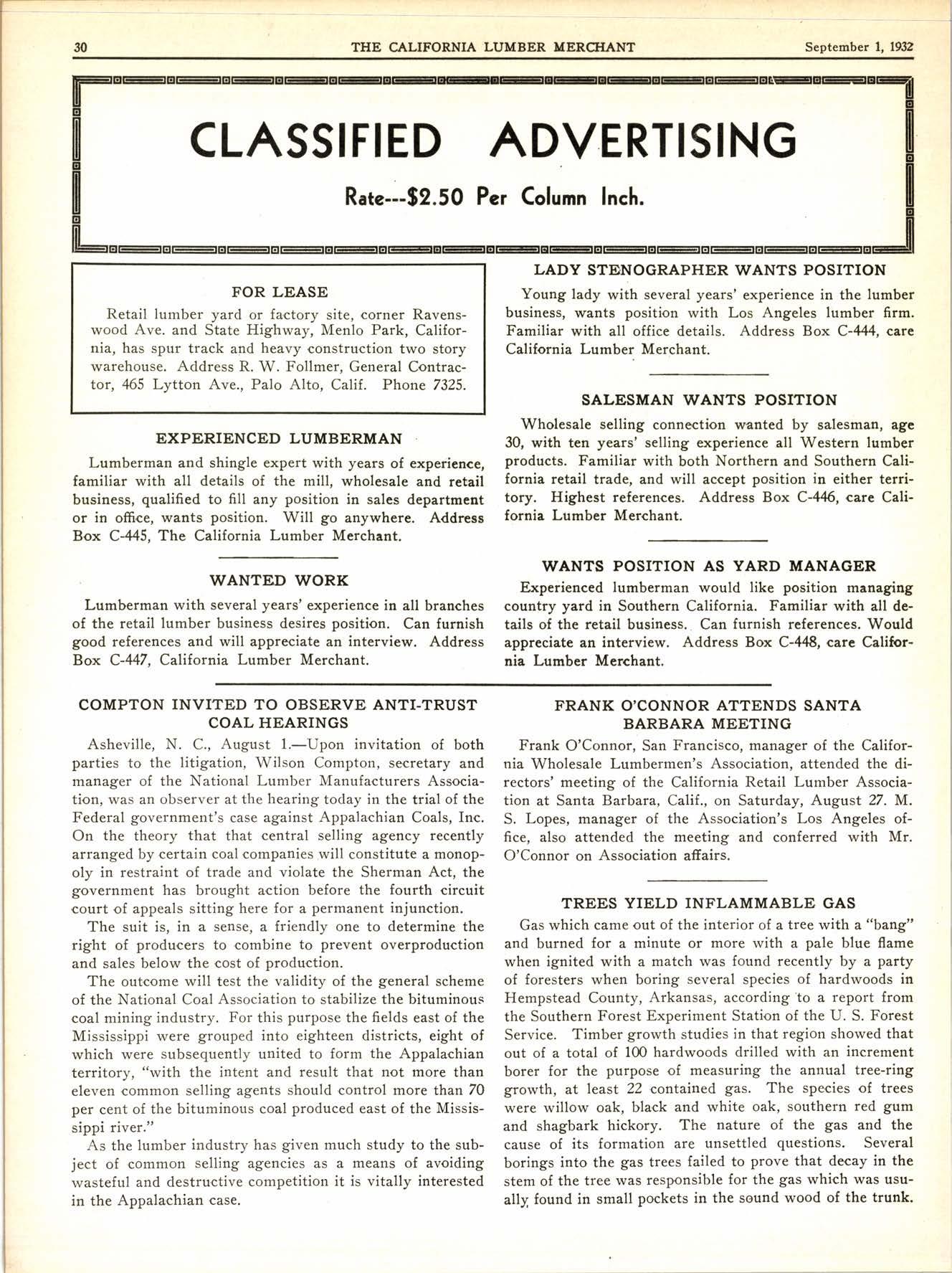
2 minute read
Lumber Industry First in California in \(/ages Paid
Washington, August 10.-More wages are paid to the lumber and timber products industry in California than to any other manufacturing industry, according to the National Lumber Manufacturers Association. The petroleum refining industry, which in California'in 1929, reported value of products as seven times that of the lumber industry, paid only half the wages, and the canning and preserving industry, with a larger number of wage earners than any other industry, ,paid about 70 per cent of the wages paid in sawmills and logging operations.
In 1929 the lumber and timber products industry reported 2t,822 wage earners (ranking second in the state after the canning industry) ; 932,465,4O4 wages paid, and $65,197,608 value of products. Planing mills not ,connected with sawmills employed, 7,159 men, paid $11,087,017 in w'ages and reported value of products as $50,562,173.
Reported lumber production in California to the U, S. Census Bureau reached its highest in 1926, when 2,187,959,000 feet were cut in 180 mills; 1923 was the next highest year. Lumber production in 1929 was 2,063,229,000 feet, reported by 169 mills, and in 1930, 1,5L4,263,W feet, reported by 155 mills, including one mill from Nevada each year. Of the 1930 production, 400,108,000 feet, or 26 per cent, was of redwood; 844,206,ON feet, or 56 per cent of pine (Ponderosa and sugar pine) ;244,031,W feet, or 16 per cent of fir (Douglas and white); 25,104,00O feet, or 2 per cent, cedar; only 325,000 feet, hardwoods (cottonwood).
California is a state of large sawmills. Of the 155 mills reporting in 1930, seven cut more than 50,000,000 feet each; 26 cut from 15,000,000 to 50,000,000 feet each; 39 cut from 1,000,000 to 15,000,000 feet each, and 83 cut less than 1,000,000 feet each. California is next after Washington and Oregon in number of mills cutting over 50,0@,000 feet each. Nearly one-half of the lumber consumed in wood-using industries of California in 1928 was in wooden box manufacture. Sash and doors and planing mill products consumed about 40 per cent. Car construction and furniture are also important wood-using industries of the state. In 1930, California was the fourth state in shingle manufacture; in 1929, the third, being exceeded by Washington and Oregon.
Of California's domestic distribution of lumber, approximately 65 per cent is moved to points within the state; lO per cent goes to the four states of Illinois, Iowa, Michigan and Wisconsin; 7 per cent to New York, Ohio and Pennsylvania, and 6 per cent to Missouri, Texas and Oklahoma.
About eight per cent of the total softwood freight bill of the country is paid on lumber shipped to California. New York and Illinois are the only states, according to the U. S. Forest Service, whose softwood lumber receipts show higher total transportation costs.
Of total lumber sales by California sawmills in l9D, of 1,617,265,W feet, valued at $49,693,000, 43.6 per cent is reported by the Census Bureau as made through wholesalers and commission houses; 23.3 per cent through retailers; 19.5 per cent to manufacturers;4.4 per cent for export; and 9.2 per cent through all other agencies, including 4.6 per cent local sales.
Tom Hogan Hunts Deer In Modern Way
T. P. Hogan, Jr., president of the Hogan Lumber Co., Oakland, doesn't believe in losing any time when he decides to go hunting. He recently flew from Oakland in company wi(h Dr. F. M. Shook to hunt deer on the Eden Valley Ranch, which is 35 miles northeast of Willits. The plane in which the trip was made is owned by Dr. Shook, who is a prominent Oakland physician and an experienced aviator. The journey, which takes eight hours by automobile, was made in I hour, 35 minutes. The Glenn Valley Ranch is a 33,000 acre cattle ranch, owned by the Henshaw family, who are closely identified with the Riverside Portland Cement Co.










